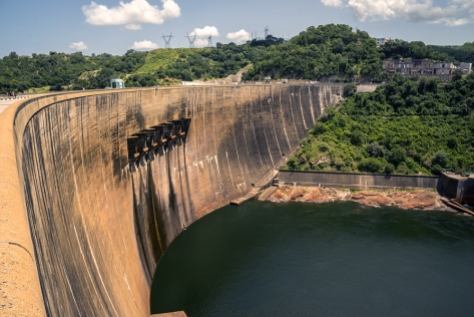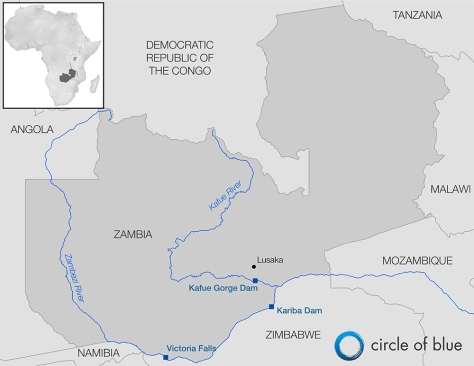One of the most interesting aspects of the daily life in Zambia is the energy supply. On one hand it perfectly seems to fit into the stereotype of developing countries, but on the other hand, when looking at the issue more closely, any stereotype is easily rebutted.
It is common knowledge that live can only exist in the presence of sufficient water. This elixir of life is what NASA is searching for on other planets to find hints for co existing species within the universe. Especially for humans water has become more than the most basic grocery. It is being used for cleaning cars as well as ourselves, its used to produce artificial snow in Dubai and, like in the case of Zambia, to produce energy. Since the first current line connected two different electricity circles in 1956, the aspect of producing and distributing energy has played a significant role in the countries development and in the quest for political power. Independence in 1964 did of course not change this.
Today, Zambia produces approximately 94% of its electrical power in hydro-power plants. The country reservoirs like the Zambezi River or the Kafue River allow Zambia a total independence from coal o other fossil energies. Neither does the country have any nuclear power plant! Electricity is produced only in Hydro- and Thermo-plants.

On a first impression this sounds magnificent, as a country whose economic boom certainly still lays ahead of us, doesn’t follow the usual line of mass consumption financed by (foreign) debts to build nuclear plants. I am well aware that Zambia is a different story than highly developed European and North American countries, as only 30% of the whole countries area is covered with adequate infrastructure to even receive electricity. But still, it seems to be a congenial approach to only use green, sustainable and natural energy.

Unfortunately, but not surprisingly, nature sets its own limits. The Zambezi River is by now the biggest natural resource of energy in Sub-Saharan Africa, and all neighboring countries use it. It goes without saying that this does not increase the amount of water over time. The tragic challenge related to this kind of energy supply is firstly an imbalanced ecosystem. Small Flo used to read the book Animals United (Die Konferenz der Tiere) – now I realize the relevance of the book’s story. Secondly, and even more urgent and visible for everyone related to Zambia, the country’s economy and therefore it’s development is extremely dependent on the intensity of natural phenomena and disasters, such as an unexpectedly long dry season. For example, this year marks the second consecutive year of extremely little rain in the wet season and an overly long dry season. In this case the great intention of supplying the country with hydro-power rapidly backfires. The reservoirs would simply be empty too quickly if the system kept running as it used to do, which would then result in a complete cut of power other than what diesel generators can produce. Even thinking about this is already scary enough.
The government’s solution so far was to cut power for 4 hours every day. This was not enough, the water level of the lakes kept decreasing immensely, especially as the rain did not start to fall. Until today there is no other solution than increasing the power cuts to 8 hours daily for private houses and small businesses.
The consequences are disastrous for the economy. Even though many companies have their own generators (also the FES office where I am working), but especially the smallest and weakest companies suffer. The large enterprises as well as clinics and hospitals and banks are exempted from the power cut, so that a minimum of public service is guaranteed. Imagine the hospitals could not admit patients anymore, when power goes off.
After all the lacking availability of power is not only an economic challenge, but a humanitarian. Especially the working class suffers, as many lose their job as the company has to cut on salaries to afford the generator’s petrol. Schoolkids and student can’t learn properly anymore, as homework cannot be done sufficiently in the dark. Also groceries turn bad once the freezers do not freeze anymore. For some families, i am convinced, this is a life threatening situation.

For the first time in my life, I realize the immediate, devastating impacts of climate change and global warming. Well, so far skiers complained about insufficient fresh powder in the alps, and maybe the thunderstorms after a hot summers day got a little more intense, but other than that the real problems of this development are yet to come, I was told.
More and more do climate conference such as the COP21 last year in Paris talk about the biased role of industrialized countries in this complex issue. More than half of CO2 emissions are produced in developed countries, whereas the developing countries have to suffer from the consequences. Zambia is not any different. The future and the prosperity of this country will strongly be interdependent with the rise of temperature. The great work of many local and international organisations trying hard to get the engine of the Zambian development running, will be wasted if climate change is not tackled seriously. This would be even more frustrating as Zambia had the potential to set structures supporting a long lasting approach from the very beginning of the state’s development, and become a role model how a economically underdeveloped country can be an ecological leader of far richer nations.

Super interessant!
Ja, interessiert und sehr!!